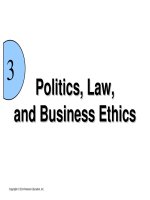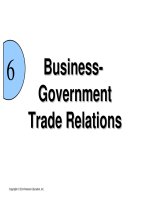Lecture International business (11/e) - Chapter 12: Labor forces
Bạn đang xem bản rút gọn của tài liệu. Xem và tải ngay bản đầy đủ của tài liệu tại đây (670.76 KB, 29 trang )
chapter twelve
Labor Forces
McGrawHill/Irwin
International Business, 11/e
Copyright © 2008 The McGrawHill Companies, Inc. All rights reserved.
Learning Objectives
Identify forces beyond management control that affect the
availability of labor
Explain the reasons that cause people to leave their home
countries
Discuss the reasons that some countries have guest
workers
Explain factors associated with employment policies,
including social roles, gender, race, and minorities.
12-3
Learning Objectives
Discuss differences in labor unions among
countries
12-4
Labor Quality and Quantity
Quality, quantity, and composition of labor
force are of great importance to an
employer
Labor Quality
The skills, education, and attitudes of
available employees
Labor Quantity
The number of available employees with the
skills required to meet an employer’s
business needs
12-5
Worldwide Labor Conditions and
Trends
Overall Size and Sector of the Work
Force
International Labor Trends
Aging of Populations
Rural to Urban Shift
Unemployment
Immigrant Labor
Child Labor
Forced Labor
Brain Drain
Guest Workers
12-6
Primary Occupation of National Labor
Force
Source: (July 25, 2006).
12-7
Aging Of Population
Source: U.S. Census Bureau, International,
“Midyear Population, by Age and Sex,”
www.census.gov/cgi-bin/ipc/idbagg (July 27,
2006
12-8
Rural to urban Shift
Source: World Urbanization Prospects: The 2003
Revision (New York: United nations, 2003), pp. 3-4.
12-9
Unemployment
• 192 million overall unemployed
– Middle East and North Africa (13.2%)
– Sub-Saharan Africa (9.7%)
– Central and Eastern Europe (9.7)
– Latin America and Caribbean (7.7)
– Developed economies (6.7%)
– Southeast Asia and the Pacific (6.1%)
– South Asia (4.7%)
– East Asia (3.8%)
12-10
Labor Mobility
Labor Mobility
The movement of people from country to country or
area to area to get jobs
Immigration
Refers to the process of leaving one’s home country to
reside in another country
Foreign-born
Population comprises those immigrants whose
move is permanent and may include taking
citizenship
Foreign
Population who are guest workers
12-11
Foreign and Foreign-Born Population
in Selected OECD Countries
12-12
Labor
• Child Labor
– The labor of children below 16 years of age
who are forced to work in production and
usually receive little or no formal education
• Primarily found in developing nations
• Existent in developed countries
• 70% is in agriculture
• Forced Labor
– Most common in South and East Asia
12-13
Brain Drain
• Brain Drain
– The loss by a country of its most intelligent and
best-educated people
– Record numbers of immigrants are moving to
OECD countries in search of jobs
– When skilled workers migrate from developing
countries they do so for professional opportunities
and economic reasons
• Reverse Brain Drain
– The growth of outsourcing and the movement of
highly educated, technologically skilled employees
and research scientists to other countries
12-14
Brain Drain: Countries with the Highest
Percentage of Their College-Educated Citizens
Living in Other Countries
12-15
Guest Workers
• People who go to a foreign country legally to
perform certain types of jobs
• Guest workers provide the labor host countries
need
– Guest workers are desirable as long as the
economies are growing
– When economies slow, fewer workers are needed
and problems appear
12-16
Considerations in Employment Policies
• Social Status
– Important with respect to labor force, especially in some
cultures
– Caste: the group to which people belong in a system under
which people’s place or level in a multilevel society is
established at birth as being the same level as that of their
parents
• Sexism
– Acceptability of women as full and equal participants in the
work force ranges widely
12-17
Women’s Education
• Studies show a direct correlation between
women’s education and
– Birthrates
– Child survival rates
– Family health
– A nation’s overall prosperity
12-18
Female Illiteracy
12-19
Ratio of Wages, Woman versus Men,
Selected OECD Countries
12-20
Racism
• Black and White conflict
– U.S., South Africa, Great Britain and
elsewhere
• Arab-, Indian-, or Pakistani and Black
conflict
– Africa
• Tamils and Sinhalese Conflict
– Sri Lanka
12-21
Minorities
Traditional Societies
Tribal peoples before they turn to organized
agriculture or industry; traditional customs
may linger after the economy changes
Minorities
A relatively smaller number of people
identified by race, religion, or national origin
who live among a larger majority
12-22
Employer-Employee Relationships
Labor Market
The pool of available potential employees
with the necessary skills within commuting
distance from an employer
A company must study the labor market when
considering whether to invest in a country
Sources include
Foreign Labor Trends
Handbook of Labor Statistics
Yearbook of Labor Statistics
12-23
Country Strike Rates, Selected OECD
Nations
Source: Rachel Beardsmore, "International Comparisons of Labour Disputes in 2004," in Office for
National Statistics (U.K.), Labor Market Trends, April 2006, p. 119, . c Crown
Copyright. Reproduced under the terms of the Click-Use License.
12-24
Labor Unions
• Organizations of workers
• European labor
– Identified with political parties and socialist ideology
• United States labor
– Laborers already have many civil rights
– Collective bargaining
• The process in which a union represents the
interests of a bargaining unit (which sometimes
includes both union members and nonmembers)
in negotiations with management
12-25









